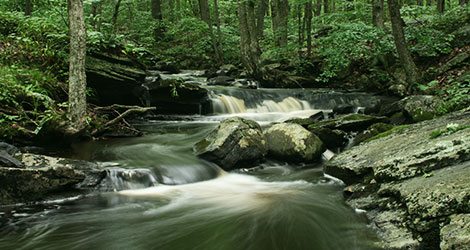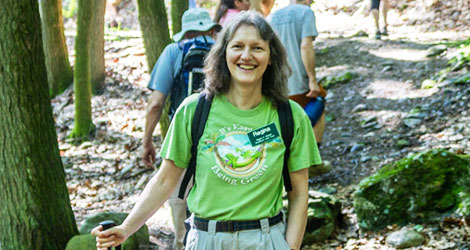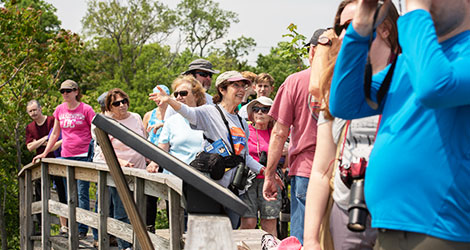
Floods, Fires, and Food: Combating Eco-anxiety in a Changing Climate
A growing number of Americans are feeling anxious and stressed about the climate crisis. One way to manage such emotions is to get more involved in creating positive change.
By Jennifer Sprague
When Austin Serio thinks about the future of our planet, he thinks about floods, fires, and food. “How are my kids going to get food that nourishes them?” he asks.
Katharine Lange worries about where that food will come from, how it will remain affordable, and how our species and seasons will change.
Keila Silva is anxious that the resources we depend on will be inadequate to sustain us.
Serio, Lange, and Silva are not alone. A small but growing number of Americans are anxious about the climate crisis and feeling what is increasingly referred to as climate anxiety or eco-anxiety. According to a 2022 study from Yale University’s Program on Climate Change Communication, 9 percent of Americans reported feeling down, depressed, or hopeless for at least several days out of the last two weeks because of global warming, and 8 percent of Americans say they are or would be interested in seeking counseling to discuss feelings about global warming.
Among young people, the numbers tell an even more striking story. A global survey by The Lancet Planetary Health of 16 to 25-year-olds found that more than 50 percent of respondents reported feeling sad, anxious, and afraid when they think about climate change. More than one in four said their feelings about climate change negatively affected their daily life and functioning, and 68 percent said the future is frightening.
“I’ve become more hopeful because I see people working really hard and I’m seeing their successes. I’ve also become more stressed and worried because I am close to the data.”
Katharine Lange
Lange, who grew up in Lebanon and graduated from the University of Connecticut, works in environmental policy for the Massachusetts Rivers Alliance. She describes working in the environmental field as a double-edged sword.
“I’ve become more hopeful because I see people working really hard and I’m seeing their successes,” she said. “I’ve also become more stressed and worried because I am close to the data. With greater understanding comes that picture of how bad things are.”
Lange treasures her childhood memories spending summers at Girl Scouts of Connecticut’s Camp Laurel where she grew to love the outdoors. She thinks a lot about her “sense of place” and how what she loves about New England is changing.
“A lot of my memories from growing up are so tied to the season,” says Lange. “That scarf and hat I wore in the winter; fall on a college campus. Of course, we will still have seasons, but they will be different.”
What Lange describes is solastalgia, a feeling of nostalgia for one’s home environment and the way things used to be. The concept of solastalgia comes from the Australian philosopher Glenn Albrecht, who describes it as “the homesickness we feel while still at home.”
“I have such a fondness for eastern white pines and Atlantic cedars, and crocuses in the spring and lupines in June,” Lange said. “To have those key species change is going to be scary.”
Serio, who grew up in Simsbury, is a member of the Chicoran Shakori tribe of South Carolina. He works for the Urban Indigenous Collective, an organization that supports access to culturally tailored health and wellness services for Indigenous peoples in the greater New York City area, and is the cofounder and CEO of ShockTalk, a telemental health platform for Indigenous peoples.
Indigenous peoples and other marginalized communities are disproportionately impacted by the physical and mental health implications of climate change, according to the International Journal of Mental Health Systems. In these same communities, mental health services are often inadequate, creating greater risk for climate anxiety.
As Serio grapples with the historical traumas committed against Indigenous peoples and the impacts of settler colonialism, climate change can feel like another personal attack for someone who considers himself “sprung from the land.”
“Being Indigenous is fundamentally about the land, part of what makes a group indigenous as opposed to being longtime occupants,” he said. “When you talk about destruction of the biosphere, it hits home in a different way because you see yourself as part of the land and as part of nature. You understand if they’re under attack, you’re under attack.”

Serio’s family left their lives as sharecroppers in the South to move north for a better life. It’s a history he carries with him, especially when thinking about the climate.
“The story of folks going from one place to another for a better life is very common in America,” he said. “I know how hard my parents worked, so I am thinking about my descendants and what is happening to the planet.”
Many Indigenous communities think in terms of seven generations three generations forward and three generations back, says Serio.
“The goal is to be a good ancestor,” he said. “Think about how many people had to work hard for you to be here right now. We’re all playing a role for our future descendants. That’s something I think about in terms of the climate.”
Silva, a 16-year-old environmental justice advocate from Suffield, says her climate anxiety stems from wanting to do “the most I possibly can” and hitting points of burnout.
“I know I can do more,” she said. “I tend to feel overwhelmed by my stress and anger and fear and sadness. It takes a toll at that moment.”
Starting this coming July, Connecticut public schools will be required to teach climate change, but at Suffield High School, where Silva is a sophomore, a multi-week climate change unit is already part of the curriculum. During a recent lesson on hurricanes, Silva felt the atmosphere in her classroom get heavy.
“You could feel how students were hit by it,” Silva said. “We’re not talking about an abstract concept. These are people being affected.”
Managing climate anxiety starts with talking about it, said Silva.
“I am a big advocate for expressing these feelings,” she said. “So many of us share the sentiment but we’re not vocalizing it. Other people are going through the same thing, and we’re going to get through it together.”
Serio emphasizes the importance of connection to the land.
“It’s about being able to see yourself in relation to the world and the non-human forces in this world,” he said. “You are connected, and you are a part of something bigger than yourself. We each hold a piece of the puzzle and the best thing you can do is grab onto that piece and do the best you can with it.”
Lange also addresses her climate anxiety with action. She believes that each person can influence something they care about with something they’re good at.
“You don’t need to be a lawyer or a scientist,” she said. “If you care, that is the only qualification you need.”
Lange offers three paths for how to approach climate anxiety in daily life.
First, she says, normalize talking about it.
“People think about climate change as a global thing, but we know that we are experiencing impacts here,” she said. “Bring it up in conversation; talk about it with your friends.”
Second, contact your elected officials, says Lange.
“I can tell you 100 percent that they are always looking for people in their districts to share their concerns,” she said. “It is their job to improve the things where you live. They can’t do that unless they know what our concerns are.”
Third, get plugged into local volunteer groups, such as CFPA, a land trust, or a youth group.
“The best way to manage your stress and anxiety is to act on it,” Lange says. “And best to act on it with company.”
Jennifer Sprague is a marketing specialist and freelance writer. She is on the board of the Meriden Land Trust. Her favorite outdoor activities are snowshoeing and camping.





